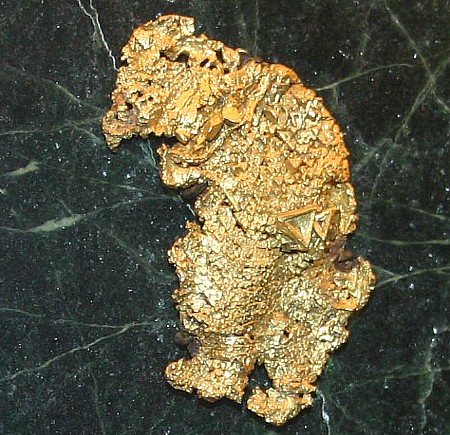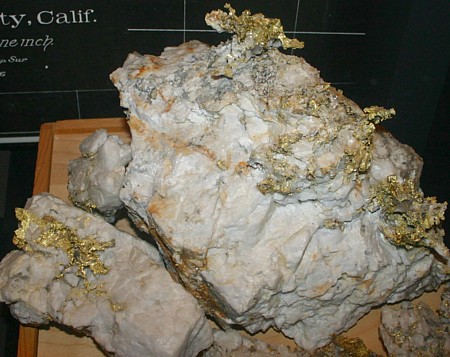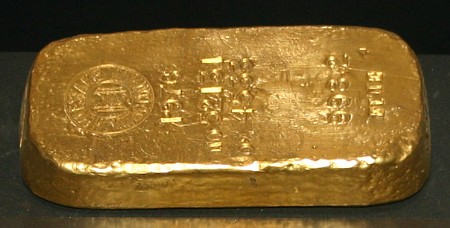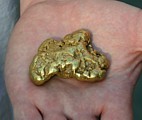| Everyone knows that gold is a valuable
commodity. Even small amounts can bring some good money. But that is just the
question: Just how do you get the best money when it comes time to sell your gold?
That is what we are going to discuss here. Almost half the battle in getting the
best price for gold is not being in a rush when it comes time to sell. A lot of guys save
up their gold, but then a crisis hits and they are forced to sell at whatever price they
can get. Unfortunately, the emergency "have to sell right now" price is
not normally as good as the price you will get if you can be choosy and wait till the
right buyer comes along. So I'd say that one of the most important things about getting
the best price for your gold is good planning. Make sure you have enough money in
the bank to cover all those little emergencies and unexpected things that come
along. If you don't have that kind of money in the bank, you ought to sell some gold
until you reach that point. Many miners strongly prefer to keep their gold
as a stash of of money. However as I've noted, unlike a bank, you can't just go out
and make an instant withdrawal as you can from your account at the local Savings and
Loan. In addition to being a stash of money, the gold you keep becomes a trophy of
the hunt, filled with great memories of good or difficult times and the efforts involved
in finding and collecting the gold. I know that for me, the gold I save is filled with
great memories of all my experiences out in the field - the desert, the pines, the
mountains. For me, I never want to sell it. It would have to be a very, very
dire emergency for me to go out and sell my gold - especially the nicer pieces. |
|
| There are a lot of different forms of natural gold and some
of course bring better prices than others. Beautiful crystalline and leaf gold specimens
as well as large nuggets will bring premium prices, so it's important to understand and
know what kind of gold you have. Lets identify a few different classes of gold for the
purposes of selling: 1. Small flakes and dust.
2. Small nuggets at least two grains in size.
3. Medium sized nuggets, one pennyweight to 1 ounce
4. Large nuggets greater than an ounce in size.
5. Good-sized gold Quartz specimens.
6. Crystalline gold specimens
Each of these categories has its own special markets that it is best
suited for. Awill big part of getting the best price for your gold is knowing what
markets are available for what you have and what appropriate prices are. Part of the
problem for me writing this article is that I know the price of gold will change, and so
if I recommend a certain price for your gold, and the price changes, it will make what I
recommend simply wrong. So for purposes of reference in this article, the price of
gold as I am writing is about $650 per ounce. You can re-figure things based on the
difference between that and the price of gold when you are reading this article. |
 |
| There is a significant collector market for
nice gold nuggets. In order to be selling your gold to collectors, you need to
have something special and collectible, not just gold dust and tiny flakes. This
usually means at least medium sized nuggets, or some special crystalline gold specimens.
Tourists and of the casual buyers may sometimes be interested in smaller nuggets, but
we'll consider that possibility a little further on in this article. You may even try
mineral specimen shops - they sometimes may make you an offer, especially if your gold is
crystalline or has other desirable properties for mineral collectors. Finding and reaching
collectors in a timely manner as always in been the problem of getting a premium price
when selling gold or other mineral specimens. The Internet of course, is the great
equalizer and there are several prospectors who are regularly marketing their gold through
Internet websites where they can get full retail prices. Creating and maintaining a
website is a whole additional proposition, but if it is your cup of tea, then it is a
great opportunity to reach and market your gold to people who are interested in buying
your gold at a reasonable price. nuggets of a pennyweight and more up to about half an
ounce, should command a price at least 35% greater than the gold weight. Nuggets of a half
ounce or better should command a 50 to 80% premium. Nuggets greater than an ounce
command a larger premium, but is variable depending on how spectacular the piece is, but
the premium is often in the range of 100% (double the gold price) and up. These prices are
figured for average pieces which are not crystalline nor reflect any special shapes or
other notable characteristics. Also remember that for American buyers, American gold
pieces are rare and therefore command a premium price. |
| |
| Jewelers will use smaller to medium sized
nuggets in making natural nugget jewelry. In some cases they will also use gold
Quartz material that has been cut up and polished into gemstones. In order to market to
jewelers, you will need these types of materials. Not all will be very interested in
what you have, and may only make a low grade offer to buy your gold cheaply. try to look
for jewelers who offer or even specialize in natural nugget jewelry - these are the ones
who are most likely to know the value of your gold and offer you a fair price if they are
looking for that type of gold. Some of the most valuable gold around is found
in crystalline gold specimens. some have little trigons like the bear shaped nugget at
right, but leaf and even wire forms are well known. These pieces can easily sell for five
times the value of the gold contained in the nugget. Be sure that if you have
crystalline gold such as the little crystalline bear pictured to the right, do you do not
let such a beautiful items go cheaply out of your hands. They are rare finds in most
gold districts, and therefore should command a premium price for their sale. Of course the
value is always in the eye of the beholder, That it may take some time to market these
high dollar pieces, but it is worth it.
There are also gold containing specimen nuggets and attractive quartz
specimens. Quartz pieces containing a high percentage of gold are sometimes sold
simply as nuggets. Quartz pieces containing only a very small percentage of gold are
perhaps best crushed in the gold extracted. I have prepared a separate Webpage on
that procedure, and you can access it at this location:
www.nevada-outback-gems.com/ |
 |
|
| Quartz with a medium amount of gold can be cut
up to produce slabs to be made into gemstones for use in gold-quartz jewelry. The goal
should be to produce material that as roughly 20 to 40 percent of the surface covered with
gold. This of course requires a thin kerfed diamond bladed saw set up for cutting hard
materials like Quartz. Such equipment is commonly available at rock hound shops, as they
also cut gemstones as well. Finally, Quartz with significant gold content
that is crystalline or leaf shaped within the Quartz matrix can be etched were treated to
produce beautiful gold Quartz specimens. There is an entire art to treating gold quartz
with hydro-fluoric acid to produce these spectacular pieces. Hydrofluoric acid is a
dangerous material that is capable of dissolving glass and Quartz. It will also
destroy your bones and the tissues of your body. Serious precautions are necessary to use
it safely. Pieces of gold Quartz are usually sawn with diamond blades of the type
mentioned above to produce a piece of the proper size and shape that the artist wishes to
develop into an attractive gold Quartz specimen. Hydrofluoric acid treatment together with
chipping in further sawing are used until the piece presents the proper level of
beauty. In many ways this art is a trial and error process, and not every piece
works out perfectly as planned. For those who would like to delve more deeply into this
subject, I have to state that it is beyond the scope of this paper and further research
would be required. |
| Getting premium prices for gold dust and small flakes takes
a little more work. In historic gold mining areas where there is significant tourist
traffic, you can usually do well selling small nuggets and flakes to tourists. Your placer
gold is weighed into small lots and put into vials filled with water. With this type of
setup, you should charge at least double the spot price of your placer. The difficulty
here is in finding a spot where you can easily sell to tourists. If you have to sit all
day and wait for people to walk by, you're not really getting much back for the time
you're investing by sitting there and selling. Another
possibility is to sell "unprocessed" gravel on ebay or other locations, and
allow people to pan out their own real gold. Some operators like Felix Paydirt of Alaska
have created an entire business out of this concept. To do this you would take a spot
where you know there is some gold present in mine the gravel. Screen to remove the larger
rocks and pebbles - anything larger than a bean. Then weigh out a fixed certain amount of
the gravel, say about 1 pound. Add an amount of gold flakes and dust, perhaps four
dollars worth if you are going to be selling the finished bag for $10. The bag of
gold bearing gravel plus the small amount of fine gold and flakes is sold as being
unprocessed gravel, guaranteed to contain gold. In this way, because you used gravel
that you knew was gold bearing there probably will be a bit more gold than you put in and
exactly how much will be determined by the buyer who purchases your bag of gold bearing
gravel. This type of product is very popular on eBay. However, it is also another
possibility where a website might be helpful in reaching the market that you are trying to
sell to. Felix Paydirt actually advertises in magazines, and sells their product through
the mail. |
 |
| |
 |
| Last but certainly not least is the possibility
of sending your gold off to a refiner. A refiner will not pay you anything extra for
beautiful specimens or nuggets, they will simply pay you for the inherent scrap value of
your gold metal. As a result the best things to send them our find flakes and dust as well
as scrap or amalgam sponge. Refiners will not accept amalgam that has not had the mercury
removed. The refiner is in business to make money for his company, he is not in business
to help you. Most refiners are honest enough and will provide you the opportunity
for your material to be tested by umpire assay if there is any dispute. Most miners who
have experienced frustration in their dealings with refiners are disappointed by the
results because they did not have a good handle on the purity of the gold they were
selling. While many placer miners will claim that their nuggets are 90 or 95% pure, that
is normally a highly unusual case. Overall impurities of 75% to 85% are far more common.
if your gold has any significant quartz or iron oxides within it, the percentages may be
even lower. It is not uncommon that small miners feel cheated or at least heavily confused
by the results of the refiners assay. There are some good things about using refiner but there are also some serious
disadvantages as well. With the refiner you know that you will get paid a fixed schedule.
However once you ship the gold, your material is basically out of your hands. You
must trust that the refiner will deal with you honestly and process your material, giving
you your full due. When you are dealing
with a Refiner, be sure to learn all the rules and requirements for shipping and policies
that the refiner enforces. Package ship your materials according to their policies. It is
worthwhile to check out the refiners website or ask around to people you know about their
experiences with that refiner. |
| When your
material begins
the refining process, it will first be logged in to their records and then melted down
into a single bar or button. An assay will be taken of that material and you will be
notified of the weight of your material and the result of the refiners assay. With
most refiners you have a certain period of time in which to respond and/or possibly
dispute the result of their assay. If you dispute it, a second assay will be taken and run
by a different laboratory and the results of the two checked against each other.
Refiners have different rules for how any discrepancies between the two assays are dealt
with. once you agree with their weight and assay results, a refiner will pay you based on
his schedules. Fees are charged for the assay and refining processes and these are
deducted from any payment you are to receive. fast payment for your gold usually also
incurs additional fees, so if you can wait a little bit and be patient, you may make a
little more money on your gold. |
 |
| While you are accumulating your gold, it is important to
carefully and safely store the gold you find until you sell it. It is not safe to have
several pounds of gold - many thousands of dollars - sitting around your house in a box or
a jar. Many prospectors and miners have had their gold stolen because they failed to keep
their gold in a safe location. Gold is valuable, and it attracts thieves. If you have more
than an ounce or two of gold around the house, you really should purchase a safety deposit
box in the vault of your local bank and make arrangements to keep your gold in the safety
of their secure vault. |



